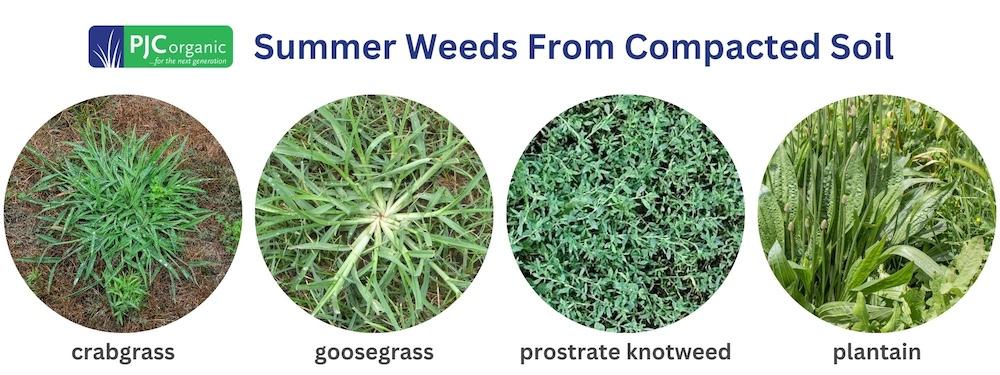Summer weeds are arriving on the coattails of spring weeds. Environmental conditions—like drought and extreme heat—make it difficult for cool-season turf grasses to compete with summer weeds. Although…fear not! Proper cultural practices and products will help you manage them.
Importantly, when scouting lawns and athletic fields for weeds, ask yourself: “Why is this weed here?”. The answer always lies in the underlying soil conditions. In this blog, we cover 4 common summer weeds that thrive in compacted soil.

1. Crabgrass
This common summer annual comes in two forms: large (hairy) and small (smooth). Germination is typically from midspring to midsummer. Flowering and seeding is aggressive from midsummer all the way to the first frost – making it extremely difficult to manage. Crabgrasses can tolerate high temperatures and dry, compacted soils better than turf grass varieties. Conversely, crabgrass does not well tolerate shaded sites (both from trees and dense turf). In response, to manage crabgrass organically: mow high, judiciously water, aerate compacted areas, and overseed with a turf type tall fescue dominant blend.
2. Goosegrass
This late summer annual, that is often mistaken for crabgrass, thrives in heavily compacted soils. It germinates 4-6 weeks after crabgrass, which can make it easier to distinguish when doing your scouting. Goosegrass is adaptable to a wide range of site conditions and can do well in nutrient deficient soil, dry soils, landscape beds and turf stands. Its smooth blade structure makes for a very poor playing surface on athletic fields because it impacts ball rolling and foot traction. A tall turf stand is essential in managing goosegrass due to its low growth habit.
3. Prostrate Knotweed
Prostrate knotweed is typically the first broadleaf summer annual to germinate in the spring. The presence of prostrate knotweed is a classic indicator of compacted soils. This quick spreading plant forms dense mats that are extremely harmful to turf, as it makes it nearly impossible for turf plants to emerge. Therefore, an aggressive aeration and overseed strategy is essential when dealing with prostrate knotweed. I’d recommend at least two aeration and overseeds a year: once in spring and once in late summer/fall to re-establish a turf stand. If resources allow, and it’s an important athletic surface, I’d even add in slice seed to damage the knotweed branches and put seed directly into the soil.
4. Plantain
A telltale sign of compaction – plantain has strong taproots that can ‘break’ poorly structured soils and steal calcium. Turf grass roots don’t have the moxie to break compacted soils and require assistance through aeration and overseeding and gypsum to provide bioavailable calcium and improve soil structure. Plantain tolerates a wide range of moisture conditions, making it extremely difficult to manage, especially on athletic fields where foot traffic from athletes is so high. This weed will start to show significant formation late spring and early summer.
Practical Approach
Above all, no matter which weeds you find when scouting in the summer, the universal step to prevention is establishing a lush turf stand, proper fertility, and appropriate cultural practices. Consequently, you’ll establish a thick stand of turf that crowds out weeds.
- Mowing: A high height of cut shades out prostrate growing weeds and limits weed seeds from getting to the soil surface.
- Watering: Deep watering encourages turf root growth and limits shallow, moist soils that certain weeds thrive in.
- Soil Testing: Keeping pH in range through liming is essential for nutrient availability and soil structure.
- Overseeding: Turf species diversity is also critical to enhancing competition on athletic fields and lawns. First, in Spring, Rye grass is going to be most prevalent. Secondly, in early Summer, tall fescues and Kentucky blue will be most competitive. Over the heat of summer tall fescue does a great job of remaining competitive. Then, in late summer and fall, Kentucky blue and rye will dominate again.
Again, when identifying summer weeds, ask yourself “Why is this weed here?” and follow up with “Am I growing the best turf grass I can be?”. As always, PJC is here for your organic turf care needs. This means: soil testing and analysis, product recommendations, organic turf care program development, and support services. Contact us with your questions, we’re here to help you implement all-natural turf care seamlessly!








